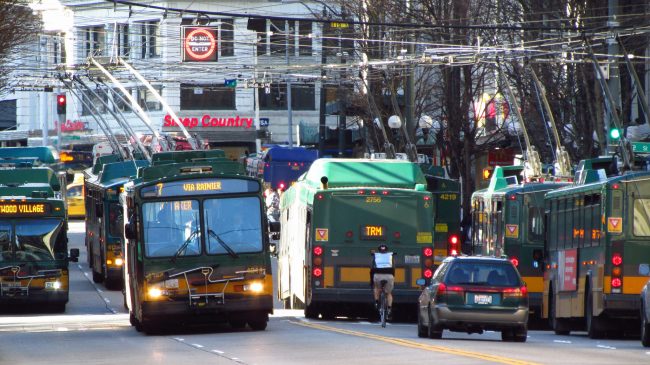Seattle is booming, and in downtown, transit has been absorbing most of the city's growth in travel. With the streets full during rush hour, the only way to increase capacity is to reallocate street space from cars to more compact modes like buses and bikes.
David Lawson at Seattle Transit Blog suggests the next step -- converting Third Street, where bus ridership is greatest and car traffic is restricted during rush hour, to a fully car-free, transit-only boulevard:
The vast, vast majority of commuters using Third do so on a bus. During each rush hour, each of the 12 blocks of Third legally accessible to cars is serving a few cars per minute, for a total of perhaps 200 cars per block, or maybe 5,000 total cars per day. Today Third alone carries well over 100,000 daily bus riders. Allowing Third to carry just one more major bus route such as the 41 or 550, with over 10,000 daily passengers each, could benefit triple or more the number of commuters who now drive cars on Third. If the City and the transit agencies are concerned about capacity through downtown, reducing congestion on Third is the most obvious possible step toward increasing it.
Banning cars would increase capacity in two ways. First, congestion from turning and stopped cars (as described below) would disappear. Second, a car ban would enable more and better-placed bus stops. With no interference from right-turning cars, a few current bus stops could be extended, and several blocks that do not currently have bus stops could host stops, increasing space for bus loading and unloading.
The highest-volume hour of the day for bus departures is 4:30 to 5:30 p.m. Today, 274 buses use Third during that hour, and the agencies believe that is the maximum possible with Third’s current configuration. An increase to 300 buses in the maximum hour could, by itself, mitigate the very worst of the forced transfers proposed for next year, while adding capacity for several thousand riders just during that single hour.
More recommended reading today: Streets.mn reports on a Minnesota bill that, if passed, would threaten people's right to protest in streets and public spaces. And Human Transit looks at the difficulties that arose after the 49ers moved from transit-accessible San Francisco to a new stadium in car-centric Santa Clara.





